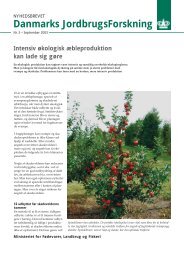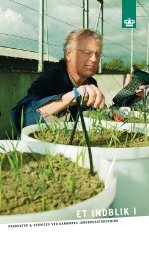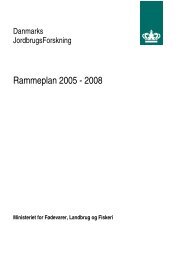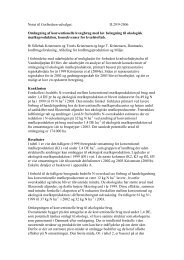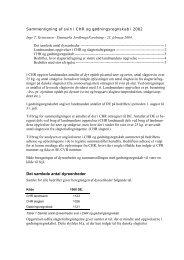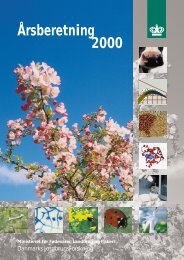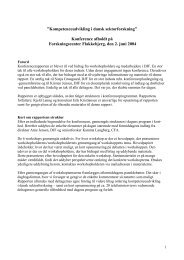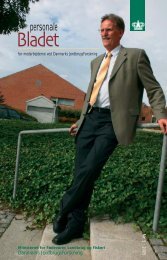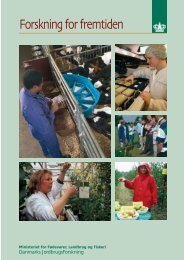Reproduction performances and conditions of group-housed non ...
Reproduction performances and conditions of group-housed non ...
Reproduction performances and conditions of group-housed non ...
Create successful ePaper yourself
Turn your PDF publications into a flip-book with our unique Google optimized e-Paper software.
- General discussion -<br />
No convincing associations were found between the indicators <strong>of</strong> stress <strong>and</strong> fear <strong>and</strong> the<br />
risk <strong>of</strong> returning to oestrus or litter size. As some <strong>of</strong> these indicators, though not pro-<br />
nounced, was significantly related to back fat gain, e.g. number <strong>of</strong> skin lesions (Paper III),<br />
the reason could be that including back fat in the statistical model left little variation to be<br />
explained by the other indicators. However, even after exclusion <strong>of</strong> back fat gain, no sig-<br />
nificant effects were found on any <strong>of</strong> the indicators <strong>of</strong> stress. This does not necessarily<br />
demonstrate that no relations between reproduction <strong>and</strong> these characteristics exist. As dis-<br />
cussed in Paper IV, it cannot be excluded that the indicators applied have been insufficient<br />
to express variation in levels <strong>of</strong> social stress. Special attention should be paid to developing<br />
additional indicators <strong>of</strong> social stress suitable for use in commercial sow herds. In this study,<br />
all the indicators <strong>of</strong> social stress were related to aggressive interactions (e.g. direct behav-<br />
ioural observations <strong>of</strong> aggressions <strong>and</strong> the number <strong>of</strong> skin lesions). However, not only<br />
physical contact but also treats <strong>and</strong> visual contact may cause stress in the low ranking sows<br />
(Ruis et al., 2002), <strong>and</strong> sows receiving many aggressions are not necessarily identical with<br />
the most submissive sows, as shown <strong>and</strong> discussed in paper III. Therefore, in any complementary<br />
future study, efforts should be made to estimate the rank (high, medium, low) <strong>of</strong><br />
the individual, focal sow. As already discussed, in <strong>group</strong> feeding systems, sows with limited<br />
access to the feed are probably identical to the most submissive sows. However, in systems<br />
with individual feeding, access to feed cannot necessarily be used as an indicator <strong>of</strong><br />
rank. In these systems it might be possible to estimate rank by provoking a competition<br />
situation e.g. by providing a small amount <strong>of</strong> feed in the corner <strong>of</strong> the pen.<br />
As presented in Paper II, human approach tests were used as indicators <strong>of</strong> fear, because it<br />
was hypothesized that submissive sows would react fearfully towards humans due to their<br />
negative experience during <strong>group</strong>ing. However, this has never been verified <strong>and</strong> some <strong>of</strong><br />
the research technicians actually had the impression that the most submissive sows were the<br />
ones that reacted most confidently towards humans. This indicates that human approach<br />
tests cannot be used for assessing the rank <strong>of</strong> the sows. This is further supported by the lack<br />
<strong>of</strong> associations between parity <strong>group</strong> <strong>and</strong> the outcome <strong>of</strong> the two fear tests performed after<br />
<strong>group</strong>ing <strong>of</strong> the sows (paper III).<br />
The results from the farm study indicated that back fat measurements <strong>and</strong> observations <strong>of</strong><br />
sows’ eating behaviour might be relevant indicators <strong>of</strong> reproduction problems since 1) they<br />
were possible to perform in sows <strong>group</strong> <strong>housed</strong> under practical <strong>conditions</strong> <strong>and</strong> 2) a relation<br />
was found between reproduction performance <strong>and</strong> these characteristics. Consequently,<br />
these indicators might be relevant ingredients <strong>of</strong> a management tool to analyse <strong>and</strong> improve<br />
the reproduction performance <strong>of</strong> <strong>group</strong> <strong>housed</strong> <strong>non</strong>-lactating sows.<br />
104




